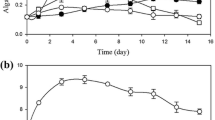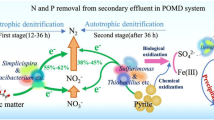Abstract
Ammonium sulfate wastewater can cause eutrophication and black odor of water body. Although ammonia nitrogen can be used as nutrient of microalgae, high ammonia nitrogen levels could inhibit the growth of microalgae. Nitrobacteria can transform ammonia nitrogen into nitrate nitrogen. In this study, mono Chlorella pyrenoidosa culture (mono-C.py), synchronous mixed culture (mixed-a), and asynchronous mixed culture (mixed-b) systems were examined for their ability to treat ammonium sulfate wastewater. Nitrogen removal rate of mixed-b at the end of culture (52.96%) was higher than that of the mono-C.py (46.37%) and the mixed-a (39.11%). Higher total suspended solid concentration (2.40 g/L), crude protein yield (0.76 g/L), and heating value yield (35.73 kJ/L) were obtained in mixed-b, meanwhile with excellent settlement performance (91.43 ± 0.51%). Mechanism analysis of settlement showed that the relative abundance of floc-forming-related bacteria Sphingopyxis and Acidovorax were increased generally, while nitrification/denitrifying members were decreased in mixed-b along with the culture proceeding.





Similar content being viewed by others
Data Availability
All data generated or analyzed during this study are included in this published article.
References
Luo X, Yan Q, Wang C, Luo C, Zhou N, Jian C (2015) Treatment of ammonia nitrogen wastewater in low concentration by two-stage ozonization. Int J Environ Res Public Health 12(9):11975–11987. https://doi.org/10.3390/ijerph120911975
Zhu G, Peng Y, Li B, Guo J, Yang Q, Wang S (2008) Biological removal of nitrogen from wastewater. Rev Environ Contam Toxicol 192:159–195. https://doi.org/10.1007/978-0-387-71724-1_5
Vergara C, Muñoz R, Campos JL, Seeger M, Jeison D (2016) Influence of light intensity on bacterial nitrifying activity in algal-bacterial photobioreactors and its implications for microalgae-based wastewater treatment. Int Biodeterior Biodegrad 114:116–121
Li K, Liu Q, Fang F, Luo R, Lu Q, Zhou W, Huo S, Cheng P, Liu J, Addy M, Chen P, Chen D, Ruan R (2019) Microalgae-based wastewater treatment for nutrients recovery: a review. Bioresour Technol. https://doi.org/10.1016/j.biortech.2019.121934
Qin L, Liu L, Wang Z, Chen W, Wei D (2019) The mixed culture of microalgae Chlorella pyrenoidosa and yeast Yarrowia lipolytica for microbial biomass production. Bioprocess Biosyst Eng 42(9):1409–1419. https://doi.org/10.1007/s00449-019-02138-1
Xia A, Murphy JD (2016) Microalgal cultivation in treating liquid digestate from biogas systems. Trends Biotechnol. https://doi.org/10.1016/j.tibtech.2015.12.010
Amenorfenyo DK, Huang XH, Zhang YL, Zeng QT, Zhang N, Ren JJ, Huang Q (2019) Microalgae brewery wastewater treatment: potentials, benefits and the challenges. Int J Environ Res Public Health. https://doi.org/10.3390/ijerph16111910
Han JC, Thomsen L, Pan K, Thomsen C (2018) Two-step process: enhanced strategy for wastewater treatment using microalgae. Bioresour Technol 268:608–615. https://doi.org/10.1016/j.biortech.2018.08.054
Chang JS (2018) Microalgae-based wastewater treatment and circular economy. New Biotechnol 44:S162–S162. https://doi.org/10.1016/j.nbt.2018.05.1178
Cai T, Park SY, Li Y (2013) Nutrient recovery from wastewater streams by microalgae: status and prospects. Renew Sustain Energy Rev 19:360–369. https://doi.org/10.1016/j.rser.2012.11.030
Serejo ML, Posadas E, Boncz MA, Blanco S, Garcia-Encina P, Munoz R (2015) Influence of biogas flow rate on biomass composition during the optimization of biogas upgrading in microalgal-bacterial processes. Environ Sci Technol 49(5):3228–3236. https://doi.org/10.1021/es5056116
Coppens J, Lindeboom R, Muys M, Coessens W, Alloul A, Meerbergen K, Lievens B, Clauwaert P, Boon N, Vlaeminck SE (2016) Nitrification and microalgae cultivation for two-stage biological nutrient valorization from source separated urine. Bioresour Technol 211:41–50. https://doi.org/10.1016/j.biortech.2016.03.001
Praveen P, Guo YC, Kang H, Lefebvre C, Loh KC (2018) Enhancing microalgae cultivation in anaerobic digestate through nitrification. Chem Eng J 354:905–912. https://doi.org/10.1016/j.cej.2018.08.099
Nguyen TDP, Le TVA, Show PL, Nguyen TT, Tran MH, Tran TNT, Lee SY (2019) Bioflocculation formation of microalgae-bacteria in enhancing microalgae harvesting and nutrient removal from wastewater effluent. Bioresour Technol 272:34–39. https://doi.org/10.1016/j.biortech.2018.09.146
Qin L, Wang Z, Sun Y, Shu Q, Feng P, Zhu L, Xu J, Yuan Z (2016) Microalgae consortia cultivation in dairy wastewater to improve the potential of nutrient removal and biodiesel feedstock production. Environ Sci Pollut Res Int 23(9):8379–8387. https://doi.org/10.1007/s11356-015-6004-3
Li Y, Sun Y, Li L, Yuan Z (2018) Acclimation of acid-tolerant methanogenic propionate-utilizing culture and microbial community dissecting. Bioresour Technol 250:117–123. https://doi.org/10.1016/j.biortech.2017.11.034
Cole JR, Wang Q, Cardenas E, Fish J, Chai B, Farris RJ, Kulam-Syed-Mohideen AS, McGarrell DM, Marsh T, Garrity GM, Tiedje JM (2009) The Ribosomal Database Project: improved alignments and new tools for rRNA analysis. Nucleic Acids Res 37(Database issue):D141-145. https://doi.org/10.1093/nar/gkn879
Li Y, Sun Y, Yang G, Hu K, Lv P, Li L (2017) Vertical distribution of microbial community and metabolic pathway in a methanogenic propionate degradation bioreactor. Bioresour Technol 245(Pt A):1022–1029. https://doi.org/10.1016/j.biortech.2017.09.028
Zhu S, Qin L, Feng P, Shang C, Wang Z, Yuan Z (2019) Treatment of low C/N ratio wastewater and biomass production using co-culture of Chlorella vulgaris and activated sludge in a batch photobioreactor. Bioresour Technol 274:313–320. https://doi.org/10.1016/j.biortech.2018.10.034
Qin L, Liu L, Wang Z, Chen W, Wei D (2018) Efficient resource recycling from liquid digestate by microalgae-yeast mixed culture and the assessment of key gene transcription related to nitrogen assimilation in microalgae. Bioresour Technol 264:90–97. https://doi.org/10.1016/j.biortech.2018.05.061
Rajagopal R, Masse DI, Singh G (2013) A critical review on inhibition of anaerobic digestion process by excess ammonia. Bioresour Technol 143:632–641. https://doi.org/10.1016/j.biortech.2013.06.030
Akerstrom AM, Mortensen LM, Rusten B, Gislerod HR (2014) Biomass production and nutrient removal by Chlorella sp. as affected by sludge liquor concentration. J Environ Manag 144:118–124. https://doi.org/10.1016/j.jenvman.2014.05.015
de Morais MG, Costa JAV (2007) Biofixation of carbon dioxide by Spirulina sp. and Scenedesmus obliquus cultivated in a three-stage serial tubular photobioreactor. J Biotechnol 129(3):439–445. https://doi.org/10.1016/j.jbiotec.2007.01.009
Kim HS, Park WK, Lee B, Seon G, Suh WI, Moon M, Chang YK (2019) Optimization of heterotrophic cultivation of Chlorella sp. HS2 using screening, statistical assessment, and validation. Sci Rep. https://doi.org/10.1038/S41598-019-55854-9
Summerfelt ST, Zuhlke A, Kolarevic J, Reiten BKM, Selset R, Gutierrez X, Terjesen BF (2015) Effects of alkalinity on ammonia removal, carbon dioxide stripping, and system pH in semi-commercial scale water recirculating aquaculture systems operated with moving bed bioreactors. Aquacult Eng 65:46–54. https://doi.org/10.1016/j.aquaeng.2014.11.002
Peccia J, Haznedaroglu B, Gutierrez J, Zimmerman JB (2013) Nitrogen supply is an important driver of sustainable microalgae biofuel production. Trends Biotechnol 31(3):134–138. https://doi.org/10.1016/j.tibtech.2013.01.010
Lee J, Cho DH, Ramanan R, Kim BH, Oh HM, Kim HS (2013) Microalgae-associated bacteria play a key role in the flocculation of Chlorella vulgaris. Bioresour Technol 131:195–201. https://doi.org/10.1016/j.biortech.2012.11.130
Heylen K, Vanparys B, Peirsegaele F, Lebbe L, De Vos P (2007) Stenotrophomonas terrae sp. nov. and Stenotrophomonas humi sp. nov., two nitrate-reducing bacteria isolated from soil. Int J Syst Evol Microbiol 57(Pt 9):2056–2061. https://doi.org/10.1099/ijs.0.65044-0
Yu L, Liu Y, Wang G (2009) Identification of novel denitrifying bacteria Stenotrophomonas sp. ZZ15 and Oceanimonas sp. YC13 and application for removal of nitrate from industrial wastewater. Biodegradation 20(3):391–400. https://doi.org/10.1007/s10532-008-9230-2
Ren Y-X, Yang L, Liang X (2014) The characteristics of a novel heterotrophic nitrifying and aerobic denitrifying bacterium, Acinetobacter junii YB. Bioresour Technol 171:1–9. https://doi.org/10.1016/j.biortech.2014.08.058
Su JF, Zhang K, Huang TL, Wen G, Guo L, Yang SF (2015) Heterotrophic nitrification and aerobic denitrification at low nutrient conditions by a newly isolated bacterium, Acinetobacter sp. SYF26. Microbiology 161(Pt 4):829–837. https://doi.org/10.1099/mic.0.000047
He T, Li Z, Sun Q, Xu Y, Ye Q (2016) Heterotrophic nitrification and aerobic denitrification by Pseudomonas tolaasii Y-11 without nitrite accumulation during nitrogen conversion. Bioresour Technol 200:493–499. https://doi.org/10.1016/j.biortech.2015.10.064
Li C, Yang J, Wang X, Wang E, Li B, He R, Yuan H (2015) Removal of nitrogen by heterotrophic nitrification–aerobic denitrification of a phosphate accumulating bacterium Pseudomonas stutzeri YG-24. Bioresour Technol 182:18–25. https://doi.org/10.1016/j.biortech.2015.01.100
Heylen K, Lebbe L, De Vos P (2008) Acidovorax caeni sp. nov., a denitrifying species with genetically diverse isolates from activated sludge. Int J Syst Evol Microbiol 58(Pt 1):73–77. https://doi.org/10.1099/ijs.0.65387-0
Chakraborty P, Sarker RK, Roy R, Ghosh A, Maiti D, Tribedi P (2019) Bioaugmentation of soil with Enterobacter cloacae AKS7 enhances soil nitrogen content and boosts soil microbial functional-diversity. 3 Biotech 9(7):253. https://doi.org/10.1007/s13205-019-1791-8
Tian HL, Zhao JY, Zhang HY, Chi CQ, Li BA, Wu XL (2015) Bacterial community shift along with the changes in operational conditions in a membrane-aerated biofilm reactor. Appl Microbiol Biotechnol 99(7):3279–3290. https://doi.org/10.1007/s00253-014-6204-7
Chen Q, Ni J (2011) Heterotrophic nitrification-aerobic denitrification by novel isolated bacteria. J Ind Microbiol Biotechnol 38(9):1305–1310. https://doi.org/10.1007/s10295-010-0911-6
Wang H, Song Q, Wang J, Zhang H, He Q, Zhang W, Song J, Zhou J, Li H (2018) Simultaneous nitrification, denitrification and phosphorus removal in an aerobic granular sludge sequencing batch reactor with high dissolved oxygen: effects of carbon to nitrogen ratios. Sci Total Environ 642:1145–1152. https://doi.org/10.1016/j.scitotenv.2018.06.081
Young S (2001) Pulp mill effluent induced coagulation and flocculation in receiving waters [D]. University of Alberta (Canada). https://doi.org/10.7939/R34Q7QR7X
Dertli E, Mayer MJ, Narbad A (2015) Impact of the exopolysaccharide layer on biofilms, adhesion and resistance to stress in Lactobacillus johnsonii FI9785. BMC Microbiol 15:8. https://doi.org/10.1186/s12866-015-0347-2
Jimenez JA, La Motta EJ, Parker DS (2007) Effect of operational parameters on the removal of particulate chemical oxygen demand in the activated sludge process. Water Environ Res 79(9):984–990. https://doi.org/10.2175/106143007x175717
More TT, Yadav JS, Yan S, Tyagi RD, Surampalli RY (2014) Extracellular polymeric substances of bacteria and their potential environmental applications. J Environ Manag 144:1–25. https://doi.org/10.1016/j.jenvman.2014.05.010
Alleman JE, Preston K (1991) Behavior and physiology of nitrifying bacteria. In: Proceedings of the second annual conference on commercial
Funding
This work was supported by the National Natural Science Foundation of China (51861145103 and 21878291); the Science and Technology Planning Project of Guangzhou (202102080406); the Natural Science Foundation for Research Team of Guangdong Province (2016A030312007).
Author information
Authors and Affiliations
Contributions
LQ and SF carried out the experiments and wrote the manuscript. PF analyzed the data. ZW and SZ supervised the experimental work and revised the manuscript.
Corresponding authors
Ethics declarations
Conflict of interest
The authors declare that they have no known competing financial interests or personal relationships that could have appeared to influence the work reported in this paper.
Additional information
Publisher's Note
Springer Nature remains neutral with regard to jurisdictional claims in published maps and institutional affiliations.
Rights and permissions
About this article
Cite this article
Qin, L., Feng, S., Feng, P. et al. Treatment of Synthetic Ammonium Sulfate Wastewater by Mixed Culture of Chlorella pyrenoidosa and Enriched Nitrobacteria. Curr Microbiol 78, 3891–3900 (2021). https://doi.org/10.1007/s00284-021-02646-y
Received:
Accepted:
Published:
Issue Date:
DOI: https://doi.org/10.1007/s00284-021-02646-y




